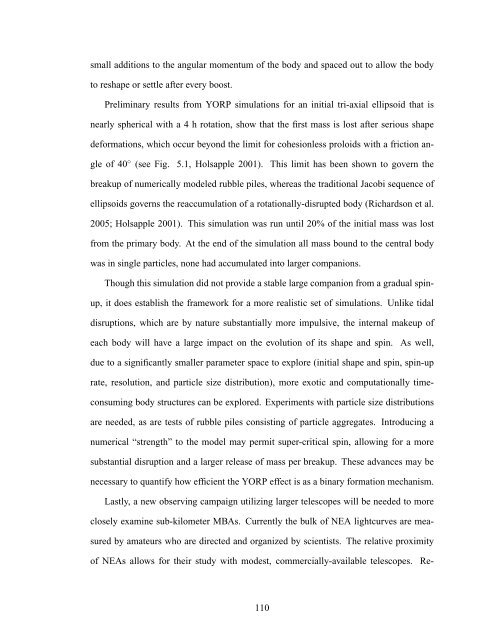Forming Binary Near-Earth Asteroids From Tidal Disruptions
Forming Binary Near-Earth Asteroids From Tidal Disruptions
Forming Binary Near-Earth Asteroids From Tidal Disruptions
Create successful ePaper yourself
Turn your PDF publications into a flip-book with our unique Google optimized e-Paper software.
small additions to the angular momentum of the body and spaced out to allow the bodyto reshape or settle after every boost.Preliminary results from YORP simulations for an initial tri-axial ellipsoid that isnearly spherical with a 4 h rotation, show that the first mass is lost after serious shapedeformations, which occur beyond the limit for cohesionless proloids with a friction angleof 40 ◦ (see Fig. 5.1, Holsapple 2001). This limit has been shown to govern thebreakup of numerically modeled rubble piles, whereas the traditional Jacobi sequence ofellipsoids governs the reaccumulation of a rotationally-disrupted body (Richardson et al.2005; Holsapple 2001). This simulation was run until 20% of the initial mass was lostfrom the primary body. At the end of the simulation all mass bound to the central bodywas in single particles, none had accumulated into larger companions.Though this simulation did not provide a stable large companion from a gradual spinup,it does establish the framework for a more realistic set of simulations. Unlike tidaldisruptions, which are by nature substantially more impulsive, the internal makeup ofeach body will have a large impact on the evolution of its shape and spin. As well,due to a significantly smaller parameter space to explore (initial shape and spin, spin-uprate, resolution, and particle size distribution), more exotic and computationally timeconsumingbody structures can be explored. Experiments with particle size distributionsare needed, as are tests of rubble piles consisting of particle aggregates. Introducing anumerical “strength” to the model may permit super-critical spin, allowing for a moresubstantial disruption and a larger release of mass per breakup. These advances may benecessary to quantify how efficient the YORP effect is as a binary formation mechanism.Lastly, a new observing campaign utilizing larger telescopes will be needed to moreclosely examine sub-kilometer MBAs. Currently the bulk of NEA lightcurves are measuredby amateurs who are directed and organized by scientists. The relative proximityof NEAs allows for their study with modest, commercially-available telescopes.Re-110












